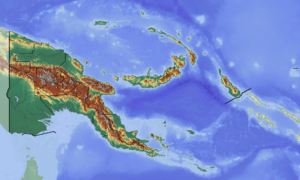Sphenophryne magnitympanum
Sphenophryne magnitympanum is a species of frog in the family Microhylidae. It is endemic to Papua New Guinea and only known from the vicinity of its type locality on the western slope of Mount Obree, Central Province.[2][1]

| Sphenophryne magnitympanum | |
|---|---|
| Scientific classification | |
| Kingdom: | Animalia |
| Phylum: | Chordata |
| Class: | Amphibia |
| Order: | Anura |
| Family: | Microhylidae |
| Genus: | Sphenophryne |
| Species: | S. magnitympanum |
| Binomial name | |
| Sphenophryne magnitympanum (Kraus and Allison, 2009) | |
| Synonyms[1] | |
| |
Etymology
The specific name magnitympanum is derived from Latin magnus meaning "large" and tympanum meaning "drum", in reference to the large tympanum.[2]
Description
Based on the type series consisting of 14 adult males and a female, males measure 17–27 mm (0.7–1.1 in) and females about 27 mm (1.1 in) in snout–vent length. The snout is gently angulate. The eyes are moderately large. The tympanum is distinct and large. The canthus is rounded but distinct. A pair of angular dermal ridges runs in the scapular region. The fingers have small discs, those of the toes are much larger. No webbing is present. The dorsum is tan, light yellow-brown, or pink brown stippled with black. There is a pair of vague, pale lumbar ocelli. The venter varies from deep, dark yellow to pale yellow. The iris is dark brown.[2]
The male advertisement call is a single-note "boop" lasting about 0.5 seconds. The call is emitted intermittently (maximum three calls per minute, but often only about once per five minutes).[2]
Habitat and conservation
The type series was collected from lower montane rainforest at 1,640–1,840 m (5,380–6,040 ft) above sea level. Males call at night from under leaf litter, or from within shallow burrows in the soil or compacted leaf litter. The species was relatively common, but difficult to collect because of its cryptic habits; a few animals were active on the forest floor at night.[2] As of mid-2018, this species has not been assessed for the IUCN Red List of Threatened Species.[3]
References
- Frost, Darrel R. (2018). "Sphenophryne magnitympanum (Kraus and Allison, 2009)". Amphibian Species of the World: an Online Reference. Version 6.0. American Museum of Natural History. Retrieved 18 June 2018.
- Kraus, F. & Allison, A. (2009). "New species of frogs from Papua New Guinea" (PDF). Bishop Museum Occasional Papers. 104: 1–36.
- "IUCN Red List of Threatened Species". Retrieved 18 June 2018.